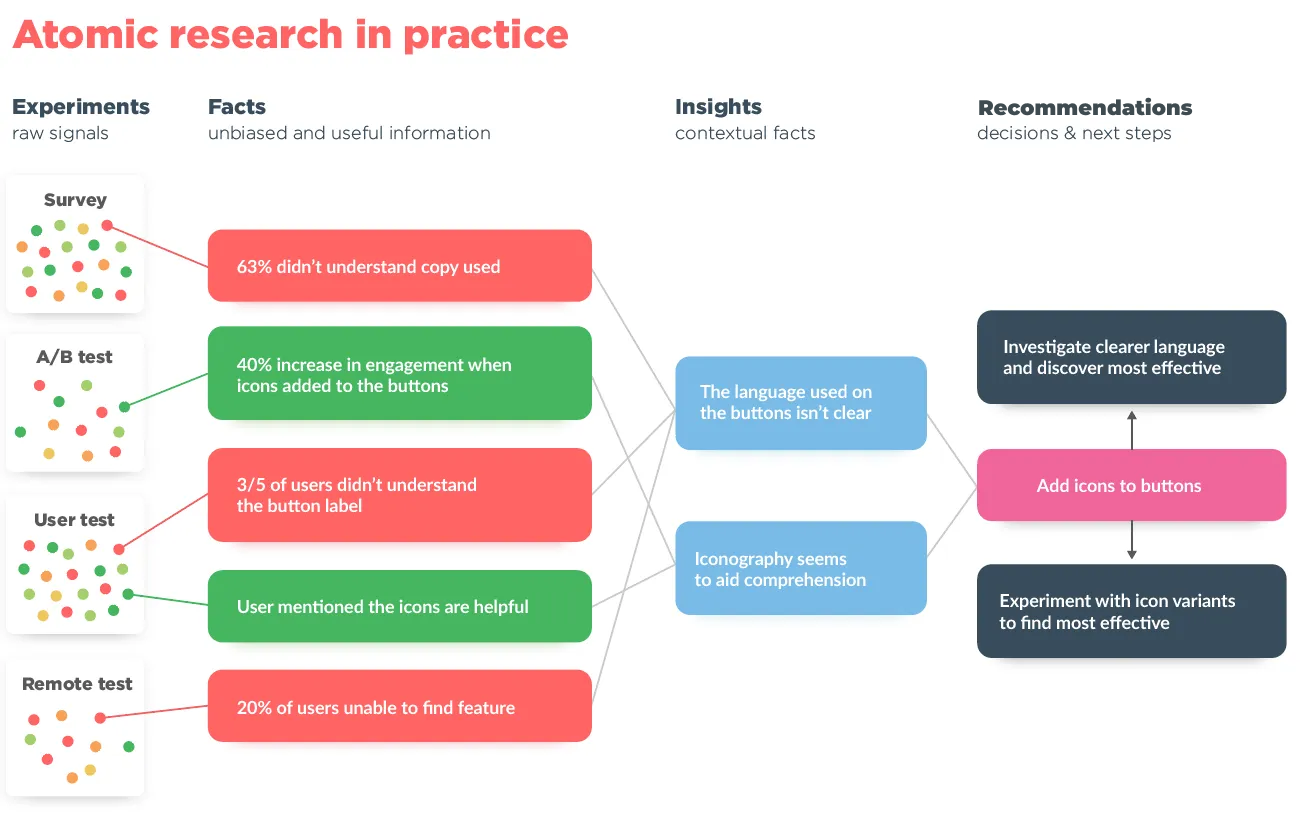What is Atomic Research?
Atomic Research is a methodology which helps organize information gathered through user research. The goal is to provide highly reliable recommendations, in order to make more relevant decisions. It allows you to anticipate the future needs, ultimately enhancing overall customer satisfaction. Let’s discover this methodology.
Atomic Research in practice
Atomic Research breaks down the knowledge gained from customers into four components:
experiments
facts
insights
recommendations
In practice, the recommendations include experiments, facts and insights:
We did a user test and a remote test (experiments),
we found out 3 in 5 users didn’t understand and 20% of users are unable to find the feature (facts),
which makes us think that the language used on the buttons isn’t clear (insights)
so we’ll add icons to buttons (recommendation).
Let’s dig into this framework :
“We did [experiments]...” - An experiment is a collection of “user interactions”. Is is a data point (a connection in analytics or a click on a A/B tested interface) for quantitative research or a verbatim (a quote extracted from unstructured text) for qualitative research.
“…we found out [facts]…” - A fact is a statement describing what was discovered based on user interactions (data points or verbatims). Facts make no assumptions and they should never reflect any opinion.
“…which makes us think [insights]…” - An insight is a sentence interpretating the chosen facts. An insight is linked to one or several facts even if they come from other experiments. Some facts might also disprove an insight.
“…so we’ll do [recommandations].” - A recommendation is a sentence presenting a relevant solutions based on one or several insights. The more insights that connect to the recommendations, the stronger the evidence supporting their value. This is particularly helpful when prioritizing work.
The origin of Atomic research
Atomic research, introduced by Daniel Pidcock in 2018 and inspired by the principles of Atomic design, aims to harness customer knowledge. It is broken down to its smallest element, a verbatim or a data point, the “atom”. These atoms are then assembled into molecules, forming intricate organisms.
The atom is a user interaction. It is a data point for quantitative research or a verbatim for qualitative research. They are stored in an experiment.
The molecule is a fact, made of several user interactions (atoms).
The organism is an insight, based on one or several facts (molecules).
The final component is a recommendation, based on several insights (organisms).
Without insights, no recommendations.
Without facts, no insights.
Without verbatims or data points, no facts.
The beauty of Atomic research is that is forces evidence-based thinking. Without insights, no recommendations. Without facts, no insights. Without verbatims or data points, no facts.
It encourages people to spend time digging into data, both qualitative and quantitative, to sort it and label it. This way, they create a solid foundation of knowledge for the entire organization.
In a nutshell, Atomic Research adds credibility to assertions by showing their provenance. It enhances trust in recommendations, allowing teams to bring customer feedback to their rightful position at the center of the decision process.
By doing that, they reduce their reporting by around 60-70%, according to Daniel Pidcock.
Most in-house teams reduce their reporting by around 60–70%.
How companies embrace Atomic research?
Companies are beginning to adopt digital tools to apply this methodology to their data. They seek to organize and share information across the whole organization. This has led to the emergence of two types of tools:
Low-code tool like Notion, Airtable or Coda. It allows UX researchers to organize data as they want, using specific tables for specific components of the Atomic research. It also allows them to easily build custom dashboards for other shareholders (Product managers, Product designers…)
UX text tagging tool like Dovetail or condens. It allows UX researchers to organize particularly well qualitative data, thanks to the tagging features, and to build insights. It provides generic dashboards about verbatims and insights.
As described, the atoms are associated to verbatims and data points. The big idea behind Atomic research is to offer a methodology allowing to mix quantitative and qualitative data to strengthen the insights. And it is built to be used at large scale.
But when we look at how Atomic research is executed, we observe that it does not succeed to scale up. In France, several organizations abandoned Atomic research for three mains reasons:
Extracting verbatims from unstructured text requires excessive resources, primarily through manual processes.
Existing tools fail to seamlessly integrate quantitative and qualitative data, limiting the depth of analysis.
Implementing low-code tools at a large scale poses significant challenges.
In France, Atomic Research does not succeed to scale up in most companies
That is why we launched Synopsis, a digital solution to leverage your customer insights. It uses AI to automatically sort and label user interactions, it builds insights mixing qualitative and quantitative data in a comprehensive way and it is usable by the whole organization seamlessly. Our aim is to bring companies closer to their customers, which is the ultimate goal of a good customer-centric company.
Sources
Request a demo - Synopsis
What is Atomic UX Research? - Daniel Pidcock
Foundations of atomic research - Tomer Sharon
Introduire la priorisation RICE au cœur de l'Atomic Research - Yolaine Mercier et Michael Baeyens
Atomic research in the European Commission — a UX case study - Pedro Almeida

